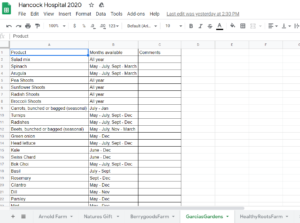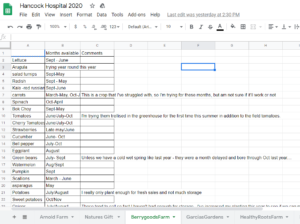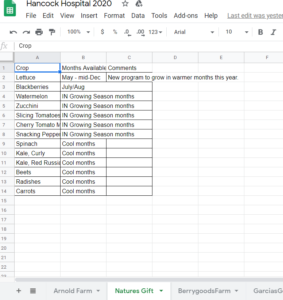Final report for FNC18-1150
Project Information
Nature’s Gift, a USDA certified organic farm, is committed to providing locally grown fresh produce all year. We believe produce that hasn’t traveled cross-nation or globally translates to the highest quality of nutrients and flavors. We are a soil-based producer using open fields during Indiana's growing season and high tunnels in colder months. The buying LOCAL movement is a strong indicator of a bright future for small farms, community health and Indiana's economy.
Nature’s Gift is a farm consisting of 100 acres.
Farming Practices:
Nature's Gift certifications: USDA Organic Certification (inspected by Ecocert, ICO); GAP (Good Agricultural Practices – U.S. Department of Agriculture), ServSafe (National Restaurant Association), Indiana Grown (Indiana Department of Ag), and "Farm to School" Registered Fruit and Vegetable Growers and Distributors (Indiana State Department of Health Farm Produce Safety Initiative), Food Permit (Johnson County Health Department and multiple surrounding county permits available upon request), Johnson County Weights and Measures (Indiana State Department of Health), Nursery Dealer (Indiana Department of Natural Resources), and Certificate of Insurance (Indiana Farm Bureau Insurance).
We are committed to caring for the environment as is evident in our organic practices. We believe in a farm that functions in the environment without harming surroundings.
Your farmer, John Woodbury:
He enjoyed pursuing Biology at Franklin College, which led to researching alternative agriculture as a career. His appreciation for healthy eco-systems led to an exploration of organic food production as a career. John’s studies expanded to include the University of Wisconsin at Stephens Point; after which in 2012 he opened Nature’s Gift, LLC. The family farm has been a large part of his life offering simple freedoms enjoyed.
May (mid): lettuce Spinach Carrots Radishes
June (mid) above items plus: Cucumbers Zucchini No radishes
July (mid) plus: Cherry tomatoes Slicing tomatoes Red potatoes Slicing onions
August: plus: Blackberries Green beans Peppers (hot & sweet) Watermelons
September (late) plus: Lettuce
October: Lettuce
November: Lettuce
December: Lettuce
The Hoosier Harvest Market, a farmer owned co-operative, was formed in 2013. Made up of 20 farmers, the co-op provides local farm products for direct to consumer purchase through their online store. The market has a goal to expand offerings into off seasons and for low-income or “at-risk” families.
Working under the guidance of three farms, Berry Goods Farm, Nature’s Gift, and Cameron Farms, a plan was established to provide produce to the local hospital, Hancock Hospital. Hospital patients are “prescribed” produce bags by their doctor and are provided with a voucher for either a large bag (for a family of four) or a small bag (for a family of two) to be picked up at the local farmers market twice a month. Once a month, bags also include eggs. This program offers prescribed patients multiple educational opportunities with brochures inside each bag and in-person demonstrations. Hancock Hospital entered into an agreement with HHM to provide bags for the winter of 2017/2018, giving the farms an increase in market opportunities and a steadier revenue stream.
All farms involved in this project have committed to growing their produce using sustainable practices, utilizing greenhouses, high tunnels and pastured egg production.
Berry Goods Farm was established by Amy Surburg in 2015. They grew vegetables and provided eggs for this project. Amy is also the president of the Hoosier Harvest Market and was the main connection person between Hancock Hospital and this project. She wrote a presentation about this project and shared it at the 2020 Indiana Small Farm Conference and also presented with Roy Ballard at the 2019 SARE educators conference on this project. She coordinated the farmers and put together the bag contents each week working in a team with the HHM market manager to get recipes into the bags for each delivery. She also connected with Mandy Gray of the Purdue Nutrition education program to schedule the monthly cooking classes, determine the recipes/vegetable content and schedule farmers to be present at each class to talk about the crops involved in the recipes, which were designed around the bags that the patients received the week of the cooking class.
Cameron Farms was established by Derrick Cameron as a wholesale distributor to institutions of higher learning. Derrick's expertise in the area of farm to institution at the bulk level helped the grant develop a broad perspective. While the details of the grant model focus on the individual packages distributing to the consumer, Derrick's perspective helped us think outside of the assumed model we've used from the beginning. His bulk framework projects were interjected throughout to help keep income diversified while building to sustainability. He tested a model requiring the same produce shipping to hospital outreach programs, which were equipped with certified kitchens. The producer could ship larger quantities in boxes versus the standard individual packaging. The distribution to the consumer was assumed by the hospital. Pricing to the Farmer/Rancher was substantially lower; but gross income for the Farmer/Rancher per delivery was substantially higher. The model was not pursued for all-year sustainability.
- Develop the Hoosier Harvest 365 delivery program as a year round, sustainable project, which will result in an increase of revenue for the HHM and increased sales for each farm involved of at least 10%.
- Increased knowledge or purchase habits of fresh produce by prescribed hospital patients through information cards, demonstration events, and ?
- Share findings through the Hoosier Harvest Market’s website, social media and public presentations. Presentations at the Indiana Small Farms Conference in 2020 will encourage the development of similar programs for both local farmers and the health
Cooperators
- (Educator)
Research
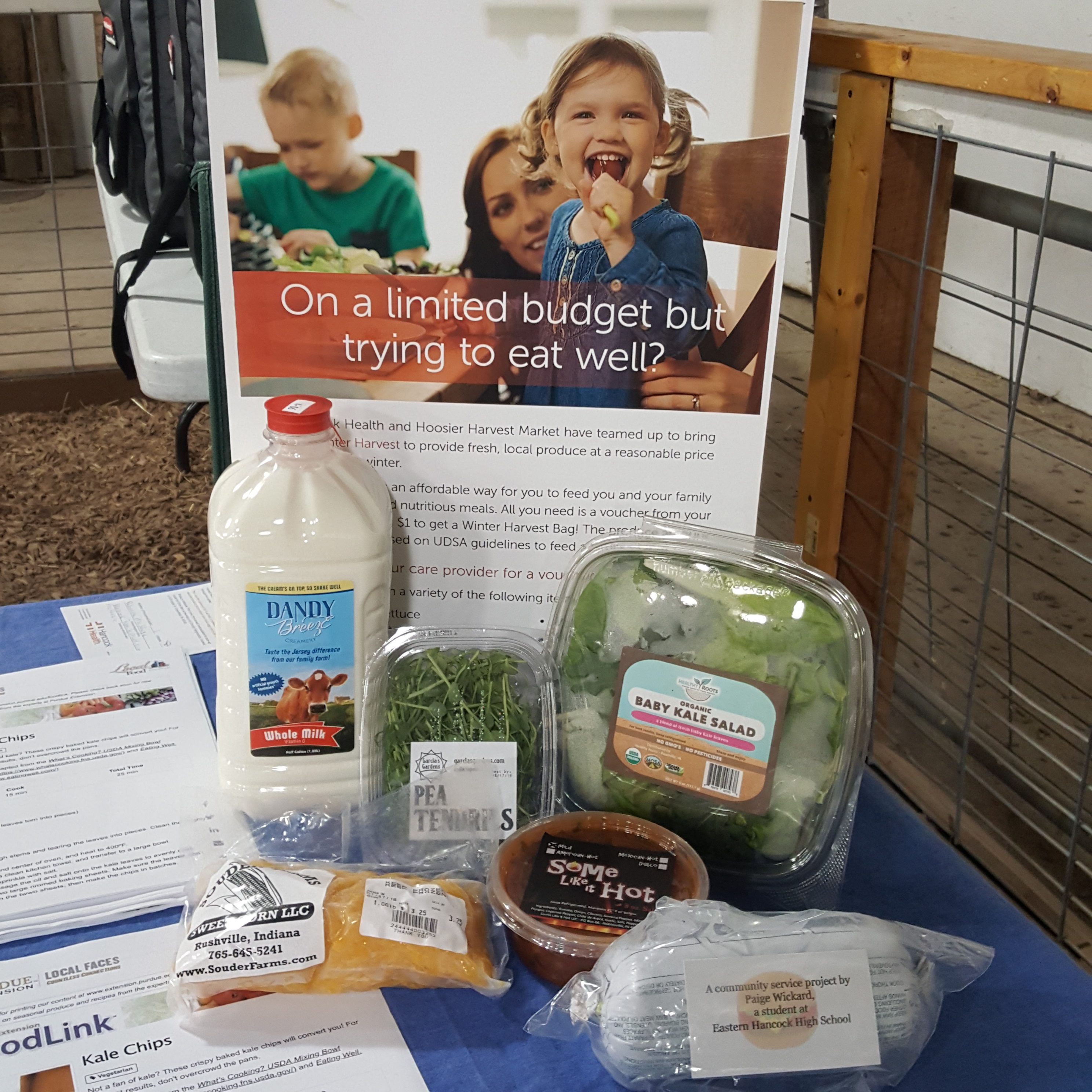
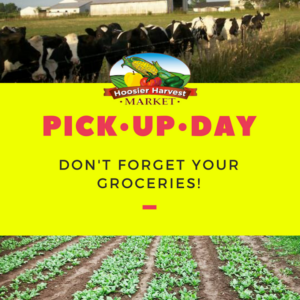
![]()
Our Market Master describes best the process involved in conducting the project. Farmers and ranchers can consider application to their operations and gain from our experiences by reviewing her narrative composed to the hospital RX patients interested in knowing more. In her words, Winter Harvest poster pdf
"It all started with a proposal from Hoosier Harvest Market to help a Greenfield, Indiana hospital extend their Healthy Harvest program through the winter with our greenhouse growers and a local farm capable of value-added frozen veggies. Winter Healthy Harvest provides fresh produce and eggs to those in need. Hoosier Harvest Market distributes produce 12 months a year. Patients of Hancock Hospital are identified by their physicians as someone who would like to eat healthier, but maybe can't afford it. Their doctor or counselor can give them a voucher for a bag of vegetables for four people at a $1 cost.
"The hospital's 'Lift' program has also raised funds through their employees to sponsor the $1 bag for people who can't afford to pay it. The bags are free for the people who are most in need. All produce is distributed either through the physicians' offices or on Saturdays at the Farmers Market on the first and third Saturday of the month. Any produce not picked up on Saturday is given to the local soup kitchen or food pantry so it can be used there to help more people. Nothing is wasted and this is truly a community effort to make our community healthier.
"We offered cooking classes, 'Healthy 365 Cooking Classes' to learn how to use their veggies.
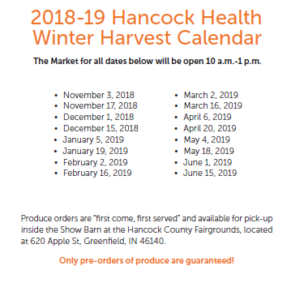
"Classes were open to the public. Interested individuals could register for the class by calling the Purdue Extension office and signing up. The class size was limited to planned produce bags.
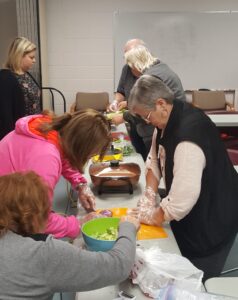
"Marketing included disclosure of Hoosier Harvest Market farmer/rancher sustainable practices. One outreach example: We informed recipients that as we begin a new year with new goals and aspirations, a lot of times the goals are centered around losing weight and healthy eating. Hoosier Harvest Market is the perfect place for this.
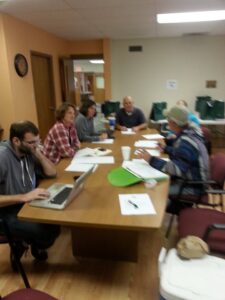
"A lot of our produce is certified organic or is grown using organic practices but is not certified organic. All of our products are grown or made in Indiana. You can identify the source immediately and even talk to the person who grew the produce or raised the animal. We also have producers describe their practices on our website so you can make your own decisions and it's not hard to find out what methods were used to grow your food." Market Master of Greenfield, Indiana.
There are just over 100 patients participating in the hospital program plus an additional 9 at the Talitha Koum house location. However, the average number of bags distributed each week is closer to 30. About one third of those contacted have become regular users of the program. A few more people participate in the cooking classes that don't receive the bags. There is also a significant crossover between the bag recipients and the cooking classes (which there should be as that's who we target for the classes).
We don't distribute bags to anyone else at the Farmers Market events. The recipes and vegetable information from Food Link are available to everyone. Our cooking demo scheduled at the Farmers Market this summer is also going to be open to the public. We are planning a local media advertising campaign for the cooking demonstrations.
Hospital statistical records of the program are tightly controlled under privacy laws. However, the attached spreadsheet reflects useful data regarding pickup and frequency per patient (identifiers redacted). The hospital is looking to gather data from the EMR system for their review. Conversations are happening with a group of physicians and their IT support for the EMR. One objective is to determine if they can extract data showing movement in areas such as diabetic A1C, etc. Part of the challenge is deciding exactly what to track and how long it might take to "move the needle" so to speak. We are talking about a relatively small sample size in regards to patient population with diverse needs. A good portion of our participants are cancer patients. Therefore, it will be challenging to get data on how the program helps them. The intuitive knowledge that their sudden change of financial and health situation puts them in a difficult position and nutrition is extremely important as they go through treatments. The hospital needs to work through the HIPAA portion of this data gathering. This aspect of our research project is in the early stages of development.
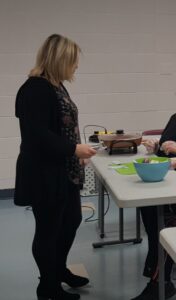
We engaged the community wellness intern in calling all of the participants this spring. The work focused on a verbal survey assessing the impact of the program. Additionally, participant satisfaction was discussed. A hospital representative working directly with our staff on this project is continuing to work for a solution to share the data from this survey with us for our final report.
The hospital bag contents maintained a diverse variety as possible (our goal). The first year program offered bags twice a month on the first and third weeks.
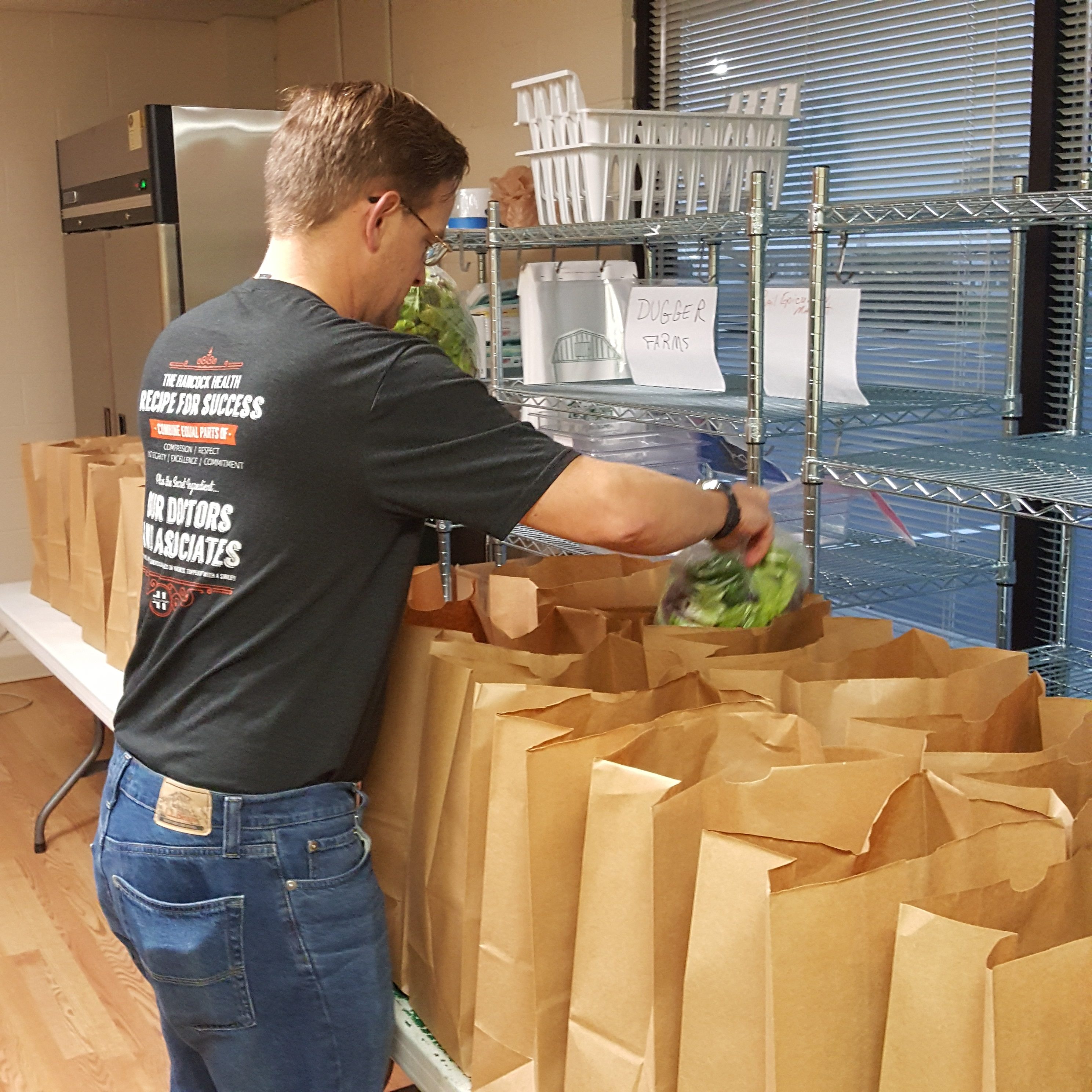
The first week of the month included eggs from our co-op members and at least 3 different seasonal vegetables.
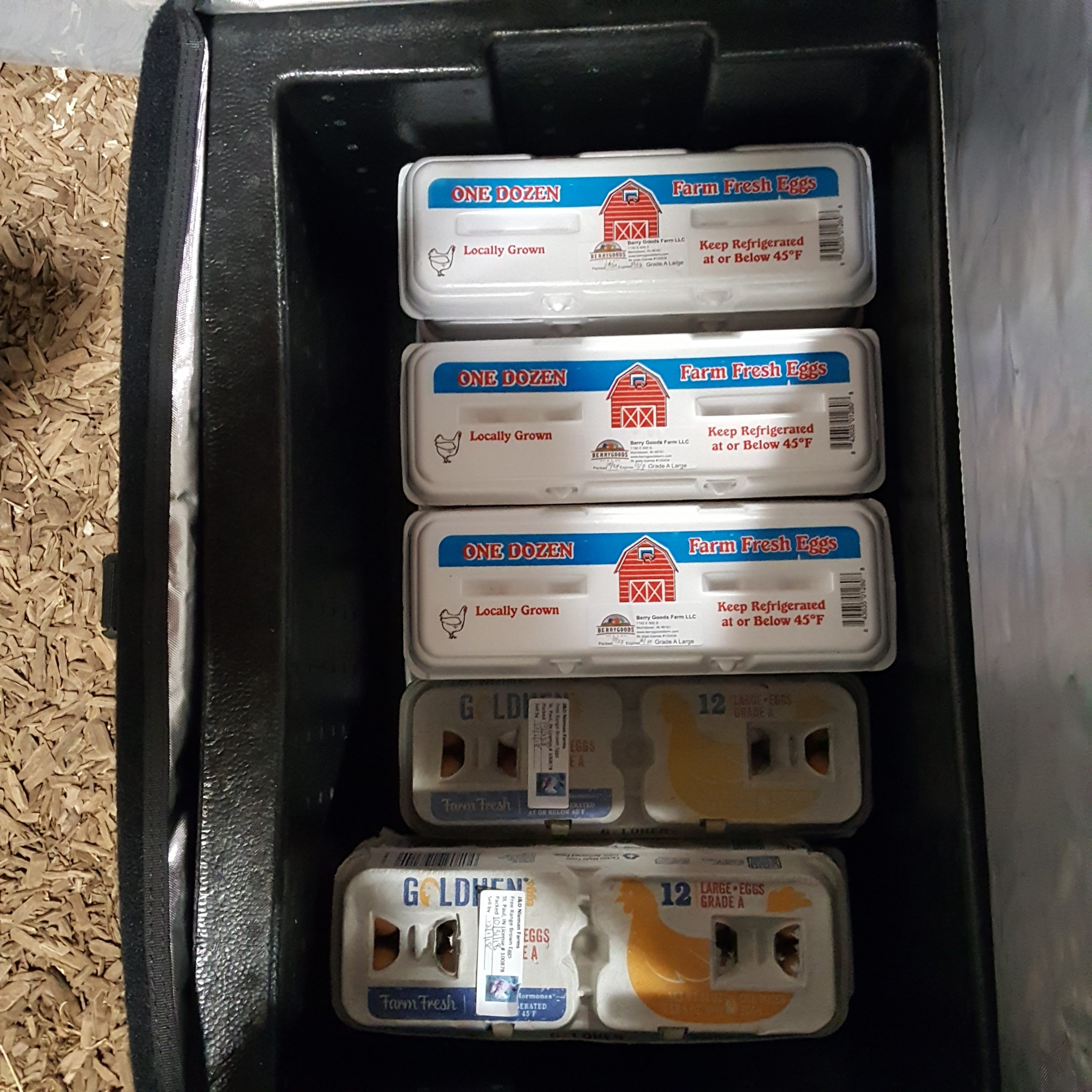
Through the winter we had apples, frozen corn, frozen green beans, cabbages, kale, lettuce, fresh herbs, micro-greens (several different types with peas shoots being the most popular), spinach and storage crops like garlic, potatoes and squash. We also had fresh salsa from one of our value-added producers and mushrooms as occasional items to add variety.
The third week of the month we included milk from a local dairy, Dandy Breeze (100% grassfed, pasteurized but not homogenized), 3 different seasonal veggies (same as above).
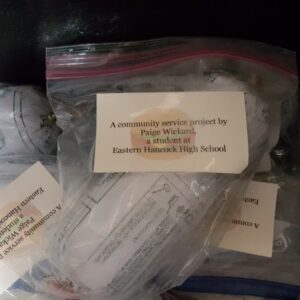
We also had a local high school FFA student donate a whole cow to the program. She had it ground into ground beef and we have been distributing one pound of ground beef in the bag each week through the winter. Another producer donated pork burgers for the bags. As of this week, we've run out of donated meat. Our local Agriculture Association has been considering another donation for the bag, but that's still in the air right now.
Second Year:
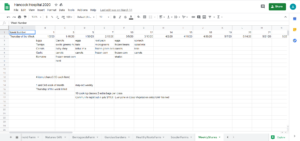
Our second year we chose to stay the course. The model we created, put in place and adjusted during our first year, we strengthened during the second year. We saw a good positive trajectory of sales, which met our goal to set-up our idea and build it into a sustainable model. Challenges regarding winter production were overcome through planning and critical discussion between the board members and Farmer/Ranchers. The Hoosier Harvest Healthy Project gained (required) strength as a movement when the Farmer/Ranchers stepped up crop planning. They realized the pending need and demand for product in the winter and off-season production infrastructure was increased.
Producer-management meetings were established for crop coordination. This became a critical component since everyone tended to grow the same items in the off-season. The consumer gained (required) a minimum variety, as a result of regular meetings among growers to coordinate product fulfillment. The Farmer/Rancher also gained (required) a usable tool specifying what to grow and when the product is needed. The Farmer/Rancher utilized Google shared spreadsheets to coordinate in between meetings. Everyone, whether management or Farmer/Rancher can be logged into the shared space and extract real-time data. Decisions may be made without burdensome phone calls. Spreadsheet data examples:
Bag items by product, ship date, package size/weight and farm;
projected/contracted produce for planning purposes by product, ship date, package size/weight and farm;
and what extra availability farms plan to grow during the seasons (i.e. when the balance of produce projected availability exceeds current purchase agreements) by product, ship date, bulk amount and farm. When sales opportunities arise, management knows what they have, or will have access to. An immediate hold can be put on the extra produce the Farmer/Rancher plans to grow = pre-sales is the safe space a Farmer/Rancher seeks.
HH-REFERRAL LIST_201905111619 We focused our work during the first year on developing a successful RX program for "at-risk" patients of one hospital. We developed a year-round program supplying produce and eggs from 10 local farmer/ranchers. The hospital budget determined the starting orders of a semi-monthly distribution. After one year, the hospital increased funding endowment for the project raising the amount ordered to a weekly distribution. This doubling of the starting point demonstrates a 100 percent increase. The year-round model we developed compared to an Indiana growing season 5-month standard program increased sales by 7 months of income.
The educational materials provided are providing recipes which are "very much appreciated" by the participants. The group of participants attending cooking classes were provided a small survey. An additional series of surveys are planned, which are projected to provide more data. While a small portion of attendees submitted the survey, we were able to see a few patterns. We see that a majority of the class participants have attended more that one class; with a core group of 4 - 5 attending all of the winter classes. On average, just under half of the people who pick up the bags on a regular basis are also attending the cooking classes.
We offered two bag sizes (large and small). However, we only distributed large bags to the hospital program, which is now 160 bags per month. The small bags are offered at the retail store and through the wellness program at New Pal schools. HH Extension to public CSA The majority of the bags sold via retail are the small size. An average of 10 bags per week through last summer and 5 bags per week through the winter of our first grant year. We found that quite a few people dropped from the program at New Pal by the end of the winter. Jan, our Market Master is working with the HR person at New Pal to secure more feedback and determine factors in the decline. We've recognized more interest as the variety grows this spring. Therefore, our strongest suspicion is the lack of variety during the winter months as a factor for declining participation at New Pal.
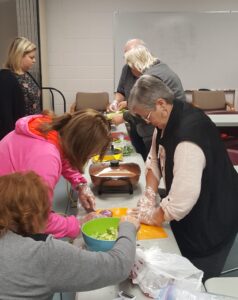
We received feedback from a number of people picking up the food. The common thread has been how much this program is helping them. Also, that they like the items received. The fact that we have a core of about 20 that come 90% of the time is our best feedback so far. We look forward to the next set of surveys to come. One of the new questions we want to add is if they are cooking more.
The doctors are not currently providing feedback to our project. The program is mainly supported by the patient care liaisons. The physicians identify the patients most in need and refer them. It's up to the patient care liaison to make sure patients are able to get the bags.
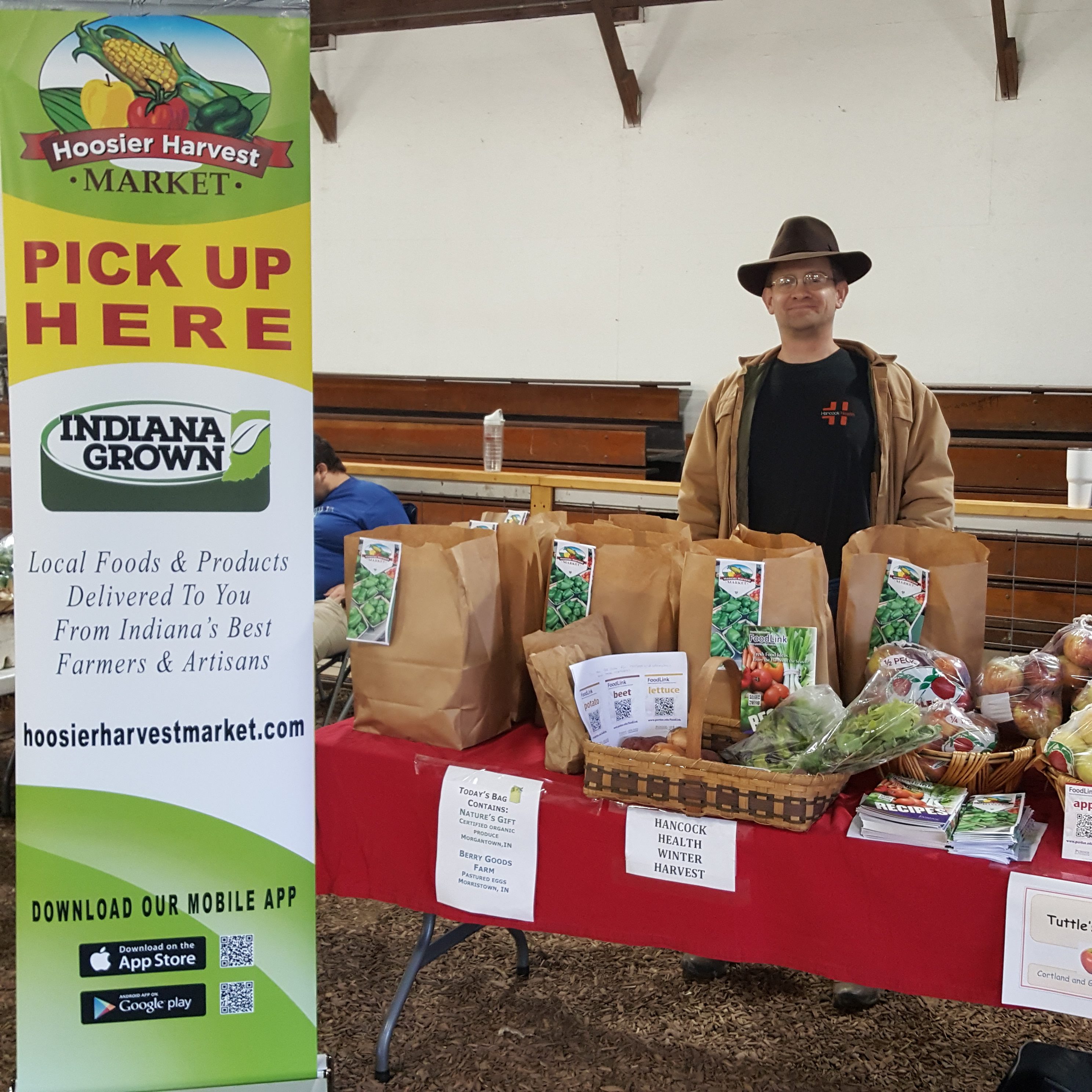
Consulting with the participants was a rewarding facet of our project. Each week when a person picks up, we go through each of the items in the bag with them. We make sure they know what it is and give several suggestions on how to use it. This was a particularly important thing to explain when we introduced the micro-greens as many had never had them before and now really like them). We also show them the recipe for that week and ask if they have questions. There are additional recipes and information on the table for them to pick up as interested.
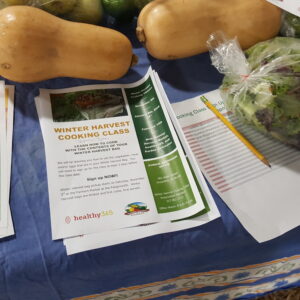
This is also the time we secure cooking class sign-ups and distribute information about up-coming events. Participants also have the option to call the extension office to sign up there. Additionally, we hold conversations with them in regards to using the bag items. If they don't want items, they have the option to leave the unwanted items in a soup kitchen donation area on our table or share it with another participant. Only occasionally, do we have someone tell us they don't like something or can't have it. In the case of kale, we discovered from feedback that they can't have it due to a high vitamin K content. We modified our contents now to offer a substitute vegetable on kale weeks. Usually, that substitute is another leafy green such as spinach or lettuce. Four to five of our regular patients that pick up need that substitution.
Educational & Outreach Activities
Participation Summary:
Our project's outreach included a monthly stand at a local farmers market where an estimated 100 individuals engaged with our project team in consultations. The rewarding experiences were the grassroots of the project education direct to the consumer. We are encouraged by the community support resulting from these interactions.
Our market master was commissioned to prepare and gather regular semi-monthly curricula, factsheets or educational tools. The materials were included in the distribution packages, as well as, made available at the monthly stand. Material focus included food preparation and nutritional benefits of consuming fresh and local foods.
Facebook newsletters materialized as the most efficient mode of education to our target audience, the consumer mindful of using fresh local products to improve their health. Therefore, every other month a newsletter was published. Newspaper, television and internal hospital no cost promotions helped build understanding and engagement in our program of which we express our appreciation. Acts like this exemplify how local food systems develop and strengthen community bonds.
We held four special presentations dedicated to cooking demonstrations and up-front personal educational experiences. Personal packages of fresh produce needed for the recipe prepared were available for all attendees. This step would serve to internalize the concept of cooking from scratch and strengthen confidence in a new found skill. We found tapping into an established cooking series, Cooking Matters, would be a good fit as well.
Two of our four special presentations were field days. Instruction along with question and answer sessions provided one-on-one interactions between the engaged consumer and the Farmer/Rancher host. This educational component was planned for strengthening the local food system.
We included ten Hoosier Harvest Market farmer/ranchers in the first year of outreach activities. We look forward to the second year which will open more opportunities due to the expansion into a weekly distribution. We feel confident the growth is an indicator of the need for and consumer acceptance of this model.
One of the beautiful things to happen during our first year was to experience professional support from community groups. Notably helpful was the constant support of an agricultural professional who integrated his established educational program with ours. We also benefited from his networking efforts with other professional institutions on our behalf for educational support staff at our workshops and produce materials.
Learning Outcomes
Having a trial run with a hospital prior to launching the grant was the strongest decision we made. The preliminary interaction established relationships, narrowed our focus and created an effective model. This step helped us move forward quickly from the start, which is critical for cash flow/financial sustainability. We added a line item for wholesale with the idea that bulk sales would provide financial stability as the main hospital outreach model strengthened. While that profit center accomplished the objective, we decided it wasn't a good idea. The complexity interfered by competing for valuable volunteer staff time. We would rethink another less-demanding income option while the project reaches sustainability.
Tapping into established programs through networking helped bridge the "building a program" gap. We learned to locate and work with knowledgeable individuals who had links to valuable resources at little or no cost. We saved valuable time and money as we learned how to engage within the local food system already in place.
We saw that hospitals go out of their way to support local for health benefits. However, we learned that outreach management is required to create a year-round program.
The outreach program increased sales by at least 20 percent annually for all participating farms. The farms also gained momentum through compliance to the required food-safety training, certifications, and insurance.
We have not overcome our main barrier of securing multiple hospital accounts, which would bring us to a sustainable model. Although, we feel strong in our accomplishments so far. We developed our annual availability program. Additionally, we increased RX distributions from semi-monthly to weekly in just one year. We carried out much education with our stand, cooking demonstrations and farmer/rancher workshops.
The advantage of implementing a hospital RX outreach program is the rewarding feelings. We are pioneering a concept with the potential to improve someone's quality of life.
Locating farmer/ranchers with the means and commitment to secure necessary safety compliance puts us at a disadvantage. There are myriads of farmer/ranchers who are missing this or that and want to participate in a local project like this. However, we find that we are a front-runner to gather those farmer/ranchers willing and able to comply.
We welcome ideas on Indiana year-round local produce programs. We believe therein is a key point to the success of future RX program growth.
Project Outcomes
Financial recommendations for future study and especially for new groups starting up a similar community movement:
This type of project needs the majority of expenses slated to management and transportation. If an entity needed to run a bare-bones project, due to normal business and a local food system ebb and flow, necessary percentages of available funds should be tightly controlled in these two areas. Sustainability will be lost or realized with management and transportation. All other remaining categories are adjustable; expensive boxes can be changed to bags, professional marketing options can be exchanged for social media options and paid-for advertising could become less expensive hand-distributed fliers or boots-on-the-ground grassroots engagement. Plan for creativity when funding runs low.
Endowment related payments are naturally seasonal (twice a year payments). Tight controls on financial management and budgeting is essential.
A 30% management profit margin is a minimum for annual financial sustainability. Midwest food production, while evolving closer to a year-round service, is still driven by a high majority of Farmer/Ranchers engaging seasonally. This factor interferes with a year-round food system entity like our farm-2-hospital outreach program. A safe space for Farmer/Ranchers to evolve (i.e. high tunnel purchasing and learning curve) is what this hospital outreach program is accomplishing. Creativity can be interjected to accomplish the financial margin. Example: The buy and resell model (buy from the producer and resell to the hospital) will not be able to withstand the 30% mark-up necessary. There are limits on both the endowment funding, as well as, on the consumer spending side. Therefore, wherever that margin is realized, take inventory of the assets available for another profit center project. This might be a delivery service for non-hospital clients for a fee, or community farm-2-table events with a plate cost, etc.
Statistical data notes:
The hospital representative is aware of institutional research on their RX program patients tied to this and other programs. However, due to HIPPA regulations that data is not shareable. We're not sure how SARE can tap into that valuable information. We suggest consideration of a work-around or a solution.
Farm-2-School local outreach through multiple state agencies is developing a booklet. The farmer/ranchers who are food safety compliant are listed in the handout. The distribution takes place in August 2019 and will go to all Indiana schools. It would be a great resource model to follow for hospital "at-risk" programs.
This hospital outreach program started with some creative thinking between a few locally connected producers. We believe in grassroots Farmer/Rancher movements. We know our efforts are proven successful and are gaining strength each year. We encourage other communities to engage their best and brightest creative thinkers to add to our study. Agriculture needs space to do the thing they do best; meeting the consumer demands for year-round local food access.
A big thanks SARE board members for all you do!
FNC18-1150 Team
